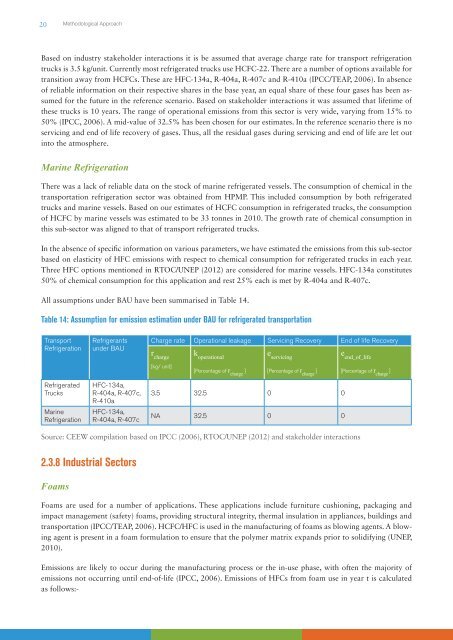Hydrofluorocarbon Emissions-Shakti Sustainable Energy Foundation
One such critically important category of gases is hydrofl uorocarbon (HFC). HFCs are potent greenhouse gases and are expected to contribute signifi cantly to global warming by 2050 (IPCC/TEAP, 2006; Velders et al., 2009; Gschrey et al., 2011; Miller & Kuijpers, 2011; Höglund-Isaksson et al., 2013). Read more information visit: http://shaktifoundation.in/report/indias-long-term-hydrofluorocarbon-hfc-emissions-detailed-cross-sectoral-analysis/
One such critically important category of gases is hydrofl uorocarbon (HFC). HFCs are potent greenhouse gases and are expected to contribute signifi cantly to global warming by 2050 (IPCC/TEAP, 2006; Velders et al., 2009; Gschrey et al., 2011; Miller & Kuijpers, 2011; Höglund-Isaksson et al., 2013). Read more information visit: http://shaktifoundation.in/report/indias-long-term-hydrofluorocarbon-hfc-emissions-detailed-cross-sectoral-analysis/
Create successful ePaper yourself
Turn your PDF publications into a flip-book with our unique Google optimized e-Paper software.
20<br />
Methodological Approach<br />
Based on industry stakeholder interactions it is be assumed that average charge rate for transport refrigeration<br />
trucks is 3.5 kg/unit. Currently most refrigerated trucks use HCFC-22. There are a number of options available for<br />
transition away from HCFCs. These are HFC-134a, R-404a, R-407c and R-410a (IPCC/TEAP, 2006). In absence<br />
of reliable information on their respective shares in the base year, an equal share of these four gases has been assumed<br />
for the future in the reference scenario. Based on stakeholder interactions it was assumed that lifetime of<br />
these trucks is 10 years. The range of operational emissions from this sector is very wide, varying from 15% to<br />
50% (IPCC, 2006). A mid-value of 32.5% has been chosen for our estimates. In the reference scenario there is no<br />
servicing and end of life recovery of gases. Thus, all the residual gases during servicing and end of life are let out<br />
into the atmosphere.<br />
Marine Refrigeration<br />
There was a lack of reliable data on the stock of marine refrigerated vessels. The consumption of chemical in the<br />
transportation refrigeration sector was obtained from HPMP. This included consumption by both refrigerated<br />
trucks and marine vessels. Based on our estimates of HCFC consumption in refrigerated trucks, the consumption<br />
of HCFC by marine vessels was estimated to be 33 tonnes in 2010. The growth rate of chemical consumption in<br />
this sub-sector was aligned to that of transport refrigerated trucks.<br />
In the absence of specific information on various parameters, we have estimated the emissions from this sub-sector<br />
based on elasticity of HFC emissions with respect to chemical consumption for refrigerated trucks in each year.<br />
Three HFC options mentioned in RTOC/UNEP (2012) are considered for marine vessels. HFC-134a constitutes<br />
50% of chemical consumption for this application and rest 25% each is met by R-404a and R-407c.<br />
All assumptions under BAU have been summarised in Table 14.<br />
Table 14: Assumption for emission estimation under BAU for refrigerated transportation<br />
Transport<br />
Refrigeration<br />
Refrigerants<br />
under BAU<br />
Charge rate Operational leakage Servicing Recovery End of life Recovery<br />
r charge<br />
k operational<br />
e servicing<br />
e end_of_life<br />
[kg/ unit]<br />
[Percentage of r charge<br />
]<br />
[Percentage of r charge<br />
]<br />
[Percentage of r charge<br />
]<br />
Refrigerated<br />
Trucks<br />
Marine<br />
Refrigeration<br />
HFC-134a,<br />
R-404a, R-407c,<br />
R-410a<br />
HFC-134a,<br />
R-404a, R-407c<br />
3.5 32.5 0 0<br />
NA 32.5 0 0<br />
Source: CEEW compilation based on IPCC (2006), RTOC/UNEP (2012) and stakeholder interactions<br />
2.3.8 Industrial Sectors<br />
Foams<br />
Foams are used for a number of applications. These applications include furniture cushioning, packaging and<br />
impact management (safety) foams, providing structural integrity, thermal insulation in appliances, buildings and<br />
transportation (IPCC/TEAP, 2006). HCFC/HFC is used in the manufacturing of foams as blowing agents. A blowing<br />
agent is present in a foam formulation to ensure that the polymer matrix expands prior to solidifying (UNEP,<br />
2010).<br />
<strong>Emissions</strong> are likely to occur during the manufacturing process or the in-use phase, with often the majority of<br />
emissions not occurring until end-of-life (IPCC, 2006). <strong>Emissions</strong> of HFCs from foam use in year t is calculated<br />
as follows:-

















